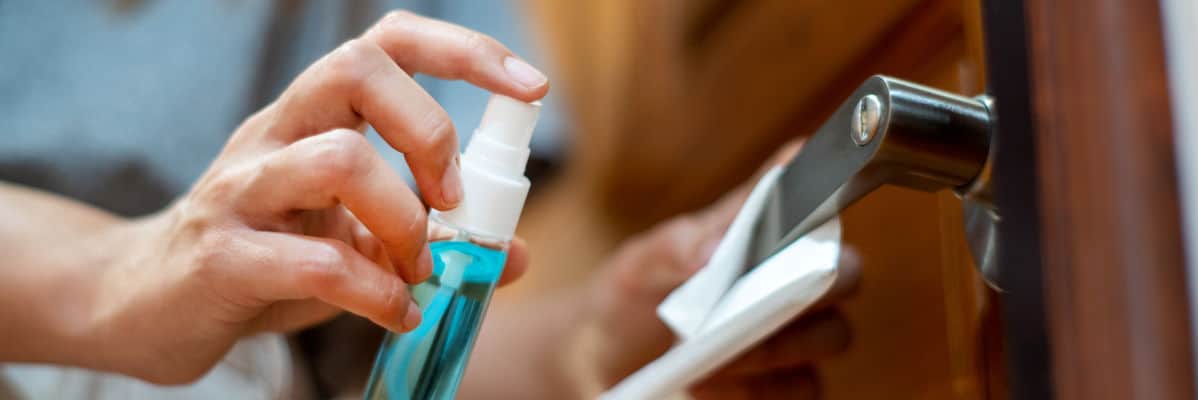Preparing for New Tenants during COVID-19

Many people are hesitant to relocate during a pandemic. In order to attract new residents, it’s important to emphasize the measures in place to protect tenant health. This includes making sure each unit has been properly sanitized between occupants and communal areas receive frequent attention.
Coronavirus Considerations for Unit Turnover
According to the U.S. Centers for Disease Control and Prevention, SARS-CoV-2, the causal agent of COVID-19, is believed to spread primarily through tiny droplets produced when an infected person coughs or sneezes. Those who are nearby may be exposed to these droplets in the air, on surfaces, or through direct contact with the mouth or nose.
When preparing rental properties for new tenants, following proper cleaning and disinfection protocols is essential. These steps can help reduce the likelihood of COVID-19 spreading to others in the event that the previous occupants may have been ill or carrying the virus without their knowledge.
The Differences between Cleaning and Disinfecting
While both cleaning and disinfection should occur before listing an open unit, it’s important to understand the distinctions between the two. Cleaning using soap and water helps to remove dirt or germs by washing or scrubbing them away. This step reduces the risk of spreading harmful pathogens from place to place.
Disinfecting, by contrast, involves killing the bacteria, fungi, or viruses on a surface that can remain even after thorough cleaning. Taking the time to disinfect lowers the potential for exposure even further, providing both landlords and renters with as much protection as possible.
There have been several alternative methods proposed to eliminate COVID-19. However, the efficacy of treatments like LED lights, ultrasonic waves, or radiation is currently unknown. The Environmental Protection Agency recommends using specific types of disinfectants against the novel coronavirus. If those are unavailable, diluted bleach or alcohol solutions can be substituted if safe for those particular surfaces.
Places that Offer Disinfection Treatments
Landlords who manage multiple locations may find it difficult to address their new cleaning and disinfection needs with their current staff or by taking a hands-on approach themselves. In these circumstances, it may be beneficial to hire an outside vendor to manage the process.
Due to the increase in demand, many businesses have adapted their offerings to include disinfecting services for coronavirus. While property managers may find treatments available through their usual cleaning company, there are other providers whose experience with strong chemicals and biohazards make them well suited for the job. Some options to consider include:
- Janitorial companies: Most commonly used by landlords for routine tasks and general upkeep of common areas, these business have changed their procedures to include using hospital grade disinfectants and sanitizers during visits.
- Environmental remediation firms: Remediation companies often handle jobs like crime scene cleanup or decontamination. Specially trained technicians remove and correct issues caused by substances including bodily fluids, hazardous waste, and blood.
- Disaster recovery services: These providers respond to emergency calls to assist with the aftermath of flooding, fires, and other catastrophes and usually operate around the clock. They may offer their services outside of traditional business hours.
- Pest control providers: Companies like Waltham Pest Services help landlords protect their property and tenants from the dangers associated with insect and nuisance animal infestations. Their equipment allows them to apply powerful yet safe disinfectant treatments over soft and non-porous surfaces and in hard-to-reach places.
Additional COVID-19 Best Practices for Landlords
There are other measures property managers and owners can take to help attract potential renters and retain current residents. The CDC’s website contains an extensive list of suggestions specifically for shared and congregate housing communities like apartment buildings. Some of the recommendations include:
- Communicate concern: Make sure all tenants and prospects know about the procedures in place to protect their well-being. Share important safety updates regularly, especially with those who may not have access to the internet. Encourage self-reporting of symptoms and update emergency contact listings so they are available in the event of illness.
- Utilize virtual tours: Avoid in-person showings during the pandemic, especially if a rental is currently occupied. Refer those interested in a property to photos online or offer to conduct a live video tour remotely if necessary instead.
- Encourage social distancing: Remind residents of the importance of keeping a distance of 6 feet between themselves and others and request that they wear masks in common areas. Consider designating directions for the flow of traffic in hallways or stairwells to reduce crowding or exposure.
- Put protections in place: Make hand sanitizer and disinfectant wipes available in areas like laundry rooms, near mailboxes, and in vestibules for residents and visitors to use. Offer disposable masks to those entering office areas.
- Manage maintenance visits: Try to limit entry into tenants’ homes to reduce potential exposure for them and for staff members. If possible, get permission to complete repairs or maintenance during times when the occupants are away or ask them to follow social distancing guidelines.
Consistency is Key
To attract and retain quality tenants, it’s important to show consideration of their welfare. Establish protocols that protect the health of residents and follow through to ensure they are adhered to. Lax safety measures or ignoring concerns can lead to negative publicity. However, transparency and open communication help establish trust and can have a positive impact on occupancy rates and the bottom line.















 Accessibility
Accessibility